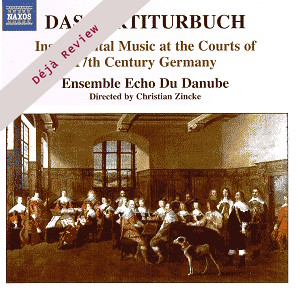
Déjà Review: this review was first published in June 2006 and the recording is still available.
Das Partiturbuch: Instrumental Music at the Courts of 17th Century Germany
Ensemble Echo du Danube/Christian Zincke
rec. 2002, Studios of Hessischer Rundfunk, Frankfurt
Naxos 8.557679 [62]
The Partiturbuch was a manuscript collection put together by Jacob Ludwig (1623-1698). Ludwig was a court musician, first in Wolfenbüttel and then in Gotha. In 1662, when working in Gotha, he presented this anthology of more or less contemporary instrumental music, written and performed at the various courts of Germany, as a birthday present, to the Duke August who had been his employer in Wolfenbüttel. The Partiturbuch contains around a hundred instrumental works by a variety of composers and a selection of these have been recorded by the Ensemble Echo de Danube on this new CD.
Perhaps the most important figure represented here is Bertali, a native of Verona, who worked for members of the Hapsburg court from 1622 onwards; from 1649 he was Kappelmeister (in succession to Giovanni Valentini) at the imperial court in Vienna. Bertali is represented more extensively than any other composer in the Partiturbuch, a just reflection of his importance. Himself a virtuoso violinist he did much to ensure the dominance of Italian taste in most of the German-speaking courts in the middle years of the Seventeenth Century. Though it was for his operas, oratorios and church music that he was most famous in his own day, it seems chiefly to have been his instrumental music which has been played and recorded in our own day – as, for example, in a recording of his Sonate Festive by Musica Fiata on CPO and a miscellany of sonatas and chaconnes by the Ricercar Consort on Mirare. (Though his ‘Lamento della Regina d’Inhilterra’ did turn up on Anne Sofie von Otter’s 1998 CD Lamenti). Bertali’s Sonata in D minor is for two violins, viola da gamba, bassoon and harpsichord, while the Sonata in G major is for two violins and bassoon (with harpsichord). Both are enjoyable, witty pieces, well performed here. More remarkable is Ciaccona in C major for violin and harpsichord – which gets a decent, if not absolutely sparking, performance.
It is good to see the music of Capricornus represented. Born into a family of Hungarian refugees, Capricornicus was a well-educated humanist who studied in Vienna (where he could hardly have escaped the influence of Bertali) before working in modern Bratislava and then becoming Kapellmeister in Stuttgart from 1657. An interesting figure, his Ciaccona is an attractive and inventive piece, which has an almost French stateliness about it.
Johann Heinrich Schmeltzer was the first native Austrian ever to be Kapellmeister at the Hapsburg court. His reputation as both violinist and composer of instrumental music stood very high in his own time and his work is increasingly finding its way on to CD. Here he is represented by an expressive Sonata variata, full of beautiful touches.
The name of Adam Drese was only a name I had seen in books before hearing this CD. He became Kappelmeister at Weimar and later held the same post at Jena, after studying with the important figure of Marco Scacchi in Warsaw. Drese travelled quite widely, at the behest of his first master, Duke Wilhelm IV of Saxe-Weimar. Eventually he became Kappelmeister at Arnstadt, and towards the end of his life became a Pietist of strict beliefs – it is said that he burned most of his secular compositions. Jacob Ludwig’s compilation preserves some work that might, perhaps, have been consigned to the flames. On this evidence Drese was a thoroughly competent composer, well steeped in the dominant Italian style.
Nathanael Schnittelbach is another whose music is very rarely heard today. Michael Fuersts’s booklet notes tell us that he came from Gdansk to Lübeck in 1655 as a municipal musician. He studied with the slightly better known Nicolaus Bleyer and furthered his career by the time-honoured tactic of marrying his teacher’s daughter. He was recognised as one of the finest violinists in Germany. His Ciaccona, which closes the CD, is a lovely piece, musically subtle and emotionally rich.
Johann Michael Nicolai ended his career in Stuttgart, having earlier worked in Thuringia, as a member of the court orchestra of the Duke of Saxe-Lauenburg. From 1655 he was a court musician in Stuttgart. The two compositions by which he is represented here are not especially individual (though the writing for the bassoon in the Sonata in C is engaging), but are assured and pleasant examples of their genre.
This is an entertaining and instructive collection, which whets the appetite for more music by these composers. Recorded in clear, well-balanced sound, the performances are entirely competent and sympathetic without being in any way remarkable. Recommended.
Glyn Pursglove
Help us financially by purchasing from



Contents
Antonio Bertali (1605-1669)
Sonata a 4 in D minor [9:29]
Ciaconna in C major for solo violin [8:45]
Sonata a 3 in G major [3:18]
Johann Michael Nicolai (1629-1685)
Sonata a 2 in A minor [3:36]
Sonata a 2 in C major [5:40]
Anonymous
Ciaconna a 3 in C major [2:17]
Johann Heinrich Schmelzer (c.1623-1680)
Sonata variata in D minor [6:38]
Adam Drese (c.1620-1701)
Sonata a 3 in A minor [4:32]
Sonata a 2 in A minor [4:10]
Samuel Capricornus (1628-1665)
Ciaconna in D major [4:17]
Nathaniel Schnittelbach (1633-1667)
Ciaconna in A major [9:36]


















